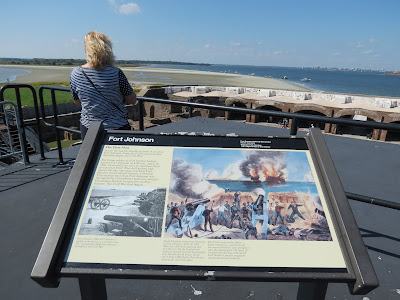Since moving to the Charleston area more than 30 years ago I have been to Fort Sumter- target of the first shots of the Civil war- maybe five times. It is always a fun place on a nice weather day to take out of town visitors.
The ferry ride from Charleston’s Liberty Square is always very scenic. There is plenty to see in all directions.
There’s a good chance you may cross paths with a large cargo ship approaching or departing the busy Charleston ports.
And dolphins may be spotted too.
We had the pleasure of showing Fort Sumter to Alesia’s longtime friend Tina who lives in the Richmond, Va. area.
Fort Sumter was high on her husband Rodger’s Charleston to-do list and we were more than happy to make it happen.
Fort Sumter visitors who arrive by ferry get to spend an hour at the site before the return trip. A ranger starts it off with a 10-15 minute presentation that is very good in setting the stage for what happened on April 12, 1861 when Confederates bombarded into surrender the Union army-occupied Harbor Fort.
Visitors don’t have to listen to the ranger talk. We can walk around at our own pace to see and touch the displays and read the historic markers.
And there’s a really good museum to tour.
Its features include flags from both sides of the conflict.
I learned some interesting new (to me) tidbits about Fort Sumter and what happened here in 1861. This to someone who feels he knows a lot about the attack and the Civil War in general. So I thought "Things I Learned" blog post (below).
Five New Facts Learned About The Fort Sumter Battle
1. Fort Sumter Was Almost Surrounded
From the excellent U.S. park service ranger (I should have taken down his name) I learned from where the Confederate cannon fire came, that it was not just from Fort Johnson.
Years ago I at some point became aware of Fort Johnson on James Island. This is where the Confederates fired the first shots of the war at 4:30 a.m. on April 12, 1862. From Fort Sumter, the side facing Charleston, Fort Johnson is the land seen in the distance over my Alesia's shoulders.
Alesia and I have been to Fort Johnson a few times and have seen this monument commemorating that near this spot “the first shot of the war on secession was fired…beginning the tragic conflict which Americans endured for four years.”
Above and below are photos I took Sunday on Sullivan's Island at Fort Moultrie. Fort Sumter can somewhat be seen in the distance, out in the harbor between the two large trees. Below is a closer view of Sumter.
This struck me as a staggering figure. The Union soldiers on Fort Sumter, for sure, gave new meaning to hunkered down. Somehow not one man was killed as iron rained down on them hour after hour. One Yankee did die but not until the Union commander had surrendered the fort and it was when a cannon misfired or exploded during a ceremonial 100 gun salute possibly when the U.S. was lowered.
4. Jefferson Davis Not Thrilled at Being Chosen CSA
President
I was surprised upon reading this display in the Fort Sumter Museum. It has a photograph of Jefferson Davis and his wife Varina. Below the image is Mrs. Davis’ recollection of her husband’s reaction when a telegram came to them in Mississippi saying "Jeff" had been elected president of the Provisional Government of the Confederate States of America. “He looked so grieved that I feared some evil had befallen our family,” Mrs. Davis would later say. “After a few minutes, he told me (what it contained), as a man might speak of a sentence of death.”
President Davis was in for a long, difficult ordeal, trying to break the Southern states from the union and keep them independent, he may have sensed.
So part of the defense was to waterproof these fortresses by using black asphalt paint, as this sign explains. The black color also helped eliminate glare from the sun that could affect firing accuracy.
So this Fort Sumter visit was fun and educational as well. I may very well learn five more tidbits and factoids next time here. Thanks to Alesia, Tina and Roger for a great time at fort Sumter!

























No comments:
Post a Comment